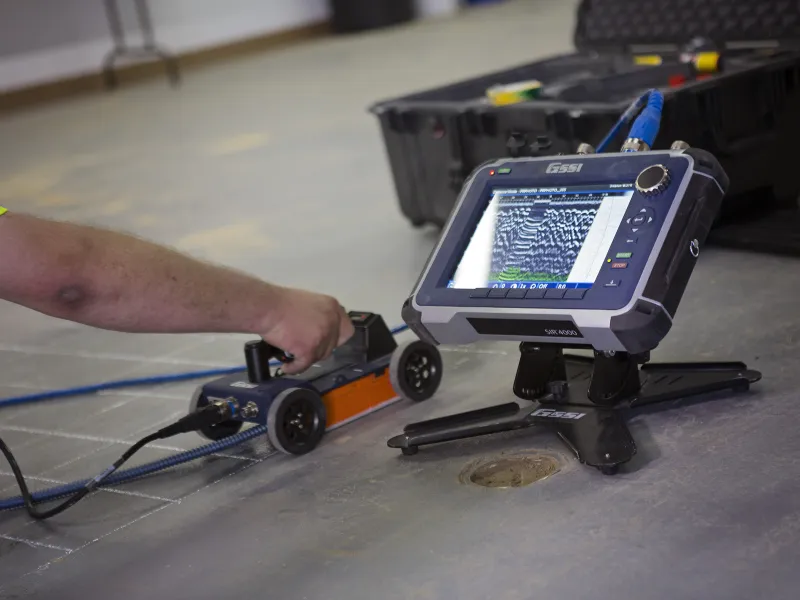Past the Surface: Leveraging Advanced Concrete Scanning Techniques for Unmatched Accuracy and Understanding
Advanced concrete scanning techniques have emerged as essential tools in this quest, supplying a glimpse below the surface area to introduce a world of important understandings. By harnessing innovative modern technologies, professionals can discover abnormalities, analyze the condition of concrete structures, and make educated decisions that shape the training course of projects.
Value of Advanced Concrete Scanning
The importance of utilizing sophisticated concrete scanning techniques exists in the unrivaled accuracy they provide for identifying sub-surface anomalies and making sure architectural stability. By utilizing sophisticated technologies such as ground-penetrating radar (GPR), electromagnetic induction, and progressed finder imaging, construction professionals can dig under the surface area of concrete frameworks with a degree of precision that much surpasses traditional inspection methods. Concrete Scanning. These strategies make it possible for the recognition of surprise threats like rebar deterioration, spaces, channels, or post-tension cable televisions that might jeopardize the stability and safety of a framework with time
In addition, progressed concrete scanning supplies indispensable understandings into the overall problem of a concrete component without the requirement for invasive measures, decreasing the risk of creating damages during the assessment procedure. The capability to pinpoint the exact area and deepness of potential issues permits for targeted repair services and maintenance, ultimately lengthening the life expectancy of the structure and maximizing its performance. Fundamentally, the relevance of sophisticated concrete scanning can not be overemphasized in the realm of building and construction and facilities maintenance, where precision and reliability are vital.
Sorts Of Cutting-Edge Technologies

Anomalies and Defect Discovery

In enhancement to GPR, concrete scanning methods like thermography and impact-echo testing are also reliable in detecting abnormalities and issues. By leveraging these sophisticated methods, professionals can proactively address structural concerns, making certain the durability and security of concrete structures.
Assessing Concrete Problem
Exactly how can designers precisely review the condition of concrete frameworks to guarantee Learn More Here their durability and security? Numerous advanced concrete scanning methods are used for this function. Ground-penetrating radar (GPR) is generally used to evaluate the interior framework of concrete, detecting spaces, fractures, and various other anomalies that may endanger its toughness.
Combining non-destructive screening methods with aesthetic evaluations enables for a detailed examination of concrete problem, enabling engineers to identify prospective concerns early on and apply timely maintenance or repair work. By leveraging these innovative strategies, designers can make certain the lasting toughness and safety and security of concrete frameworks.
Enhancing Decision-Making Procedures
In the world of infrastructure management, optimizing decision-making procedures is vital for ensuring the reliable upkeep and durability of concrete frameworks. Improved decision-making processes in concrete management entail making use of innovative scanning strategies to gather comprehensive information on the problem of frameworks. By leveraging technologies such as ground-penetrating radar and 3D imaging, stakeholders can make enlightened decisions regarding substitute, reinforcement, or fixing techniques.
These progressed scanning techniques give indispensable insights into the inner composition of concrete, recognizing potential problems such as gaps, cracks, or rust that might not be visible externally. This level of thorough info permits positive maintenance preparation, reducing the threat of structural failings and enhancing the overall life-span of concrete site structures.
Moreover, by including digital documents and analysis devices into the decision-making procedure, stakeholders can track the evolution of concrete problems in time, allowing predictive maintenance approaches and optimizing resource allotment. Ultimately, the integration of advanced concrete scanning techniques enhances decision-making procedures by giving unrivaled accuracy, insight, and performance in framework monitoring.
Final Thought
Finally, advanced concrete scanning techniques offer unmatched precision and understanding in discovering anomalies, problems, and assessing the problem of concrete frameworks. By leveraging advanced technologies, decision-making procedures can be boosted, causing even more educated and reliable solutions for maintaining and fixing concrete facilities. These methods play an important function in making sure the security and long life of concrete frameworks, making them an Get More Information important tool in the field of construction and engineering.
In addition, progressed concrete scanning offers indispensable insights right into the general condition of a concrete aspect without the requirement for invasive measures, decreasing the danger of triggering damage throughout the analysis procedure - Concrete Scanning. Another cutting-edge innovation is 3D X-ray scanning, which offers comprehensive pictures of the internal structure of concrete, offering important information without the requirement for devastating testing. In Addition, Concrete Cover Meters are utilized to gauge the thickness of concrete cover over reinforcement bars properly. Enhanced decision-making procedures in concrete management include making use of sophisticated scanning strategies to gather thorough data on the condition of frameworks.In verdict, advanced concrete scanning strategies use unrivaled precision and understanding in detecting anomalies, flaws, and examining the problem of concrete structures